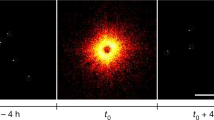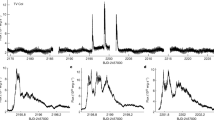Abstract
The AM Herculis-type of dwarf novae have emerged as a new class of cataclysmic variables. They are characterized by fairly steady accretion from a late-type primary on to a strongly magnetized white dwarf. The progenitor of this group, AM Herculis, shows strong optical polarization1 and prominent emission lines in both the optical2 and the UV3. It is also a hard X-ray4–6 and an IR source2. Two other X-ray sources, 2A0311–227 (ref. 7) and 2A0526–328 (ref. 8), have recently been suggested as members of the AM Her class on the strength of their similar optical spectra. To compare these objects with AM Her and to extend investigations of this new class of dwarf novae the International Ultraviolet Explorer (IUE) satellite was used to obtain their UV spectra and to search for any changes with the binary motion. We show here that the results confirm the identification of 2A0311–227 with the AM Her class, but not 2A0526–328 which seems to exhibit a UV spectrum more consistent with an SS Cygni type object. Changes in the emission lines' intensities of at least a factor of two were observed as a function of the binary phase.
This is a preview of subscription content, access via your institution
Access options
Subscribe to this journal
Receive 51 print issues and online access
$199.00 per year
only $3.90 per issue
Buy this article
- Purchase on SpringerLink
- Instant access to full article PDF
Prices may be subject to local taxes which are calculated during checkout
Similar content being viewed by others
References
Tapia, S. Astrophys. J. Lett. 212, L125 (1977).
Stockman, H. S. et al. Astrophys. J. 217, 815 (1977).
Raymond, J. C. et al. Astrophys. J. Lett. 230, L95 (1979).
Hearn, D. R. & Richardson, J. A., Astrophys. J. Lett. 213, L115 (1977).
Coe, M. J. et al. Nature 279, 509 (1979).
Swank, J. et al. Astrophys. J. Lett. 216, L71 (1977).
Griffiths, R. E. et al. Astrophys. J. Lett. 232, L27 (1979).
Charles, P. A. et al. Astrophys. J. Lett. 231, L131 (1979).
Boggess, A. et al. Nature 275, 372 (1978).
Warner, N. Mon. Not. R. astr. Soc. 191, 43P (1980).
Heap, S. R. et al. Nature 275, 385 (1978).
Hill, P. W. lAU Circ. No. 3492 (1980).
Bath, G. T., Pringle, J. E. & Whelan, J. A. J. Mon. Not. R. astr. Soc. 190, 185 (1980).
Fabbiano, G. et al. Preprint No. 80–306 (Center for Astrophysics, 1980).
Tapia S. IAU Circ. No. 3327 (1979).
Author information
Authors and Affiliations
Rights and permissions
About this article
Cite this article
Coe, M., Wickramasinghe, D. UV observations of X-ray sources 2A0311–227 and 2A0526–328. Nature 290, 119–120 (1981). https://doi.org/10.1038/290119a0
Received:
Accepted:
Issue date:
DOI: https://doi.org/10.1038/290119a0



